Global Home Potassium Monitoring Devices Market Forecast
- The approximately US$43.2 Bn market for home potassium monitoring devices (2022) poised to leapfrog to US$562.7 Bn in 2030
- Market valuation to expand at a CAGR of 44.3% over 2023 - 2030
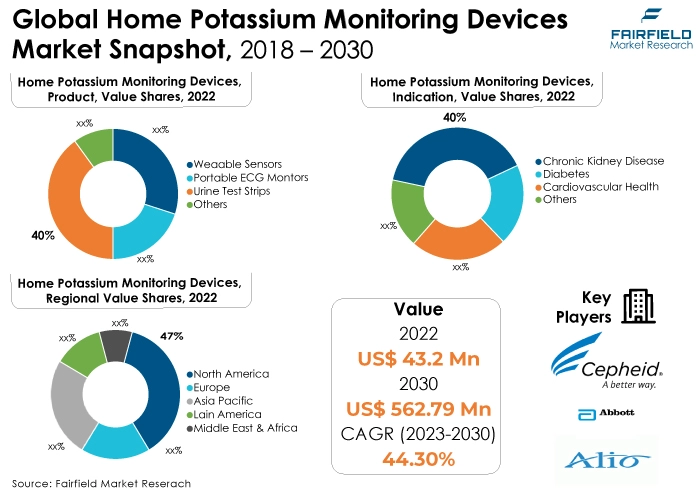
Major Report Findings - Fairfield's Perspective
- As chronic renal disease has become more prevalent, there has been an increase in the requirement for home potassium monitoring devices. These tools have made it easier to recognize problems and manage the disease.
- As disorders, including diabetes, kidney disease, and urinary tract infections (UTIs), are becoming more common, the demand for home potassium monitoring devices is increasing.
- Future development potential in developing nations like South Korea, India, Brazil, and Mexico may be anticipated by key rivals in the home potassium monitoring devices market.
- However, some challenges that hinder the growth of the home potassium monitoring devices market include false odour and the danger of developing urinary tract infections.
- In 2022, the chronic kidney disease indication category dominated the industry. The sector is expected to grow in the next years because of factors like changing lifestyles and an increase in the population of elderly people.
- In terms of market share for home potassium monitoring devices globally, the urine test strips segment is anticipated to dominate. The segment's sizable revenue share can be attributed to these aspects because of their availability, cost affordability, and user-friendliness.
- The market for home potassium monitoring devices is expected to be dominated by the North American area. A few reasons affecting regional distribution include the rise in chronic disease incidence, the presence of cutting-edge technology, and the demand for wireless and portable systems meant to reduce out-of-pocket costs.
- The market for home potassium monitoring devices is expanding in Asia-Pacific. With the growing adoption of a sedentary lifestyle in the region, which includes a bad diet, inactivity, and a high sugar intake, which led to several chronic illnesses, including obesity, diabetes, and others, it is projected that the Asia Pacific region will experience profitable growth over the projection period.
A Look Back and a Look Forward - Comparative Analysis
The market for home potassium monitoring devices is dynamic and affected by several factors. Technological developments, regulatory frameworks, reimbursement policies, and strategic alliances among market participants highly impact the market dynamics. The dynamics of the industry are also influenced by shifting patient demographics, healthcare spending, and emerging healthcare delivery models.
The market witnessed staggered growth during the historical period 2018 – 2022. The demand for home potassium monitoring devices was growing because of factors like the rising prevalence of diseases like diabetes, renal illness, and urinary tract infections (UTIs). In 2020, the National Diabetes Statistics Report estimated that 34.2 million individuals in the US have diabetes. With the increased blood sugar and blood pressure, about one-third of people with diabetes also have kidney-related comorbidities.
Key competitors in the home potassium monitoring devices market can anticipate prospective growth possibilities in developing nations like India, South Korea, Brazil, and Mexico. Governments also run screening programs to detect illnesses like renal and urinary problems early. As the number of these programs rises, there will likely be greater demand for urine testing, which will eventually boost the market for home potassium monitoring devices.
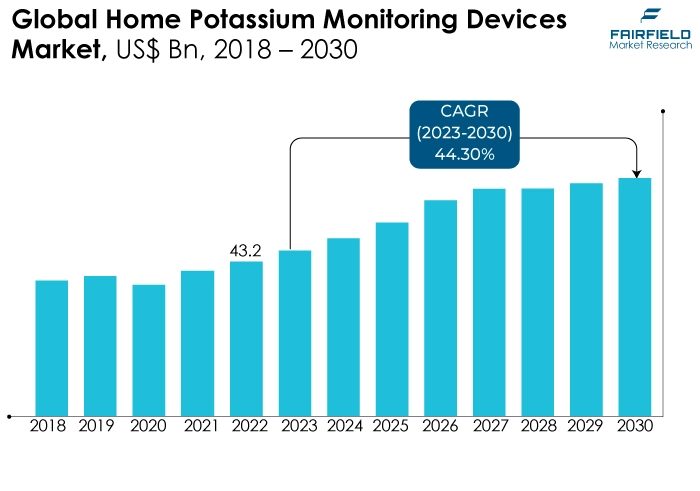
Key Growth Determinants
- Increased Prevalence of Chronic Kidney Disease
Major reasons, including the rising prevalence of chronic kidney disease among patients worldwide, are fuelling the expansion of the global market for home potassium monitoring devices. The desire for novel treatments to enhance patients' quality of life is rising as the prevalence of chronic renal disease rises.
Over 37 million Americans are expected to have chronic renal disease in the United States., according to research released by Centres for Disease Control and Prevention in 2019. Additionally, the market is primarily driven by the growing elderly population because this group of people over 60 is more likely to have chronic renal disorders than younger people.
- Growing Preference for Wearable Patient Monitoring Devices
Applications for wearable patient monitoring devices, biosensors, and smart implants include continuous glucose monitoring, temperature monitoring, blood pressure monitoring, and pulse oximetry. As wireless data transmission networks improve and become more generally accessible, it will become simpler to create platforms for telehealth and improved patient monitoring.
The Internet of Things is available on newer generations of wearable technologies. Wearable biosensors are used to measure vital indicators like potassium level, urine output, and protein in the urine, which are then sent to a central server using mobile wireless networks.
- Government Initiatives to Raise Awareness
The purpose of government screening programs is to detect urine and renal problems early. For instance, 12,487 students from elementary and secondary schools in Cangnan, Pingyang, and Yongjia in China were tested for urinalysis as part of school urine analysis programs.
Urine abnormalities were found in elementary and high school students at rates of 36.1% and 95.2%, respectively. It is anticipated that demand for home potassium monitoring devices will increase as these programs grow.
Major Challenges
- Risks Associated with System Failures
It is crucial to create methods for anticipating and correcting a system failure because equipment malfunction or inadequate planning frequently leads to system failures. Risk analysis related to system failures should be viewed as essential, especially for safety-critical applications like patient monitoring devices that deal with human health.
- Product Recalls and Failures
Due to product recalls and failures, the home potassium monitoring devices industry is expected to experience a significant drop. When home potassium monitoring equipment doesn't follow marketing criteria, the US FDA frequently removes it from the market.
Key Trends and Opportunities to Look at
- Technological Advancements
The quick technological advances have greatly improved the capabilities of home potassium monitoring devices in wireless communication, wearable sensors, miniaturization, and data analytics.
Compact, transportable, and user-friendly monitoring systems have been created due to these developments, and they are now simple to integrate into healthcare facilities, home care settings, and even mobile applications. The use of home potassium monitoring devices has expanded owing to these advancements in several healthcare settings.
- Growing Demand in Non-hospital Settings
For governments from all over the world, the sustainability of the current healthcare system is a major issue of concern. Due to escalating healthcare expenditures, particularly in hospital settings, the focus has recently switched to alternate treatment modalities, including home healthcare.
In addition, the introduction of remote and home monitoring equipment has significantly reduced the incidence of hospital readmissions. As a result, there is an increasing need for efficient home-use gadgets like home potassium monitoring devices.
- Integration of AI and Machine Learning
By providing personalized treatment suggestions, predictive analytics, and the early diagnosis of health issues that are deteriorating, Artificial Intelligence (AI), and machine learning (ML) technologies have the potential to improve home potassium monitoring devices.
Monitoring systems that incorporate AI and ML algorithms can enhance clinical judgment and patient outcomes. Organizations might investigate ways to include these technologies in their monitoring solutions.
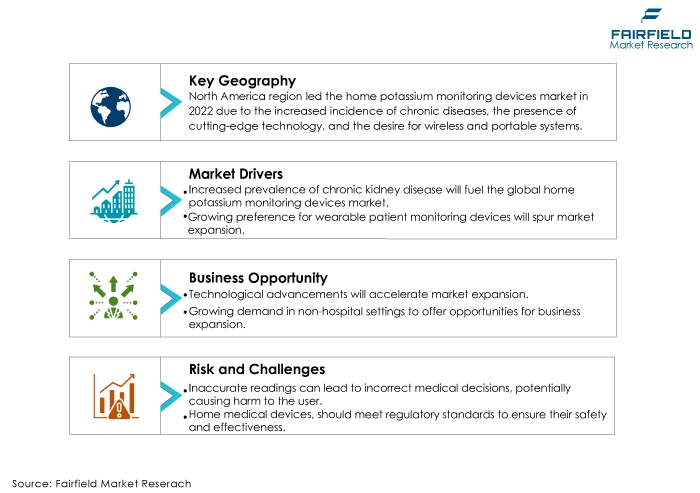
How Does the Regulatory Scenario Shape this Industry?
In the current system of approving and regulating medical devices, various nations have their own regulatory agencies that oversee multiple protocols for the licensing and regulation of devices that are divided into different classes according to the degree of risk. Medical devices are regulated by the US FDA. A gadget can be placed on the market legally if the FDA has approved it and determined that it is safe and suitable for the intended use.
Similarly, in Europe, the 'harmonization' process and EU regulations are followed to approve medical equipment. Medical Device Directives (MDD), which are composed of three fundamental directives and are modified for the safe regulation and marketing of medical devices, are the foundation of medical device regulatory processes.
The National Regulatory Authority (NRA) in India is the Central Drug Standard Control Organisation (CDSCO), which is part of Directorate General of Health Services in Ministry of Health & Family Welfare, Government of India (GoI). CDSCO is responsible for manufacturing, importing, conducting clinical trials, setting standards, selling, and distributing medical devices by enforcing medical device regulations in 2017.
Fairfield’s Ranking Board
Top Segments
- CKD Continues to Dominate over Other Indications
Chronic kidney disease (CKD) continues to dominate as a leading indicator of potassium levels due to its direct influence on potassium regulation in the body. The kidneys play a crucial role in maintaining potassium balance by excreting excess potassium through urine.
In individuals with CKD, the kidneys' ability to properly filter and regulate electrolytes, including potassium, is impaired. As CKD progresses, the risk of hyperkalemia (elevated potassium levels) increases, which can lead to serious health complications, including cardiac arrhythmias.
Monitoring potassium levels is thus essential for individuals with CKD to manage their condition and prevent adverse health outcomes. This highlights the ongoing significance of chronic kidney disease as a key indicator for the need to monitor and manage potassium levels effectively.
- Urine Test Strips Sought-after, Wearable Sensors Pick up Pace
In 2022, the urine test strips product category dominated the industry. Urine test strips are poised to dominate as the leading home potassium level-detecting product for several reasons. They offer a non-invasive and convenient method for users to regularly monitor their potassium levels.
Urine test strips are often cost-effective compared to other monitoring devices, making them more affordable for a broader range of individuals. This affordability can significantly enhance accessibility for those who need to monitor their potassium levels regularly, such as people with chronic kidney disease or those taking medications that affect potassium balance. Additionally, urine test strips are a well-established technology, with a track record in medical diagnostics.
The wearable sensors category is anticipated to grow substantially throughout the projected period. Technological advancements in sensor miniaturization, accuracy, and connectivity have made it feasible to develop wearable devices capable of measuring potassium levels with a high degree of precision. These devices can transmit data to smartphones or cloud platforms, enabling users to track their health over time and share relevant information with healthcare professionals for better guidance and treatment.
Regional Frontrunners
North American Contributes the Largest Share of Revenue
The main cause of the increase is the localized rise in the prevalence of chronic diseases. The number of people with unusually high or low blood potassium levels is increasing, which is also causing the market to grow quickly. Among the 20 million Americans who suffer from chronic renal disease, more than 500,000 have impaired kidney function and frequently need dialysis.
Because chronic kidney disease rates are increasing, a developed healthcare system, high health spending, and technologically advanced diagnostic methods are the primary market growth drivers. In addition, technological developments and the introduction of new products promote market expansion.
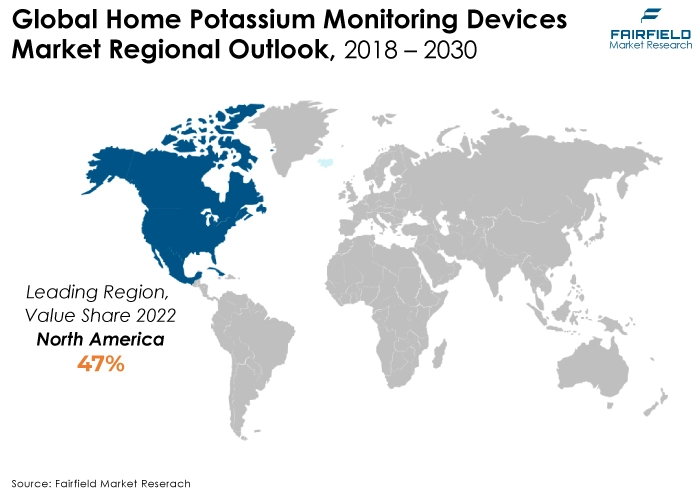
Asia Pacific Likely to Witness the Significant Growth in Sales During Forecast Period
The second-highest prevalence of chronic renal disease is thought to be in the Asia-Pacific area, which increases the need for potassium in blood monitoring devices. The frequency of CKD is frighteningly high in Asian countries with few resources.
Raising awareness, screening high-risk people, providing accessible healthcare, and delivering reasonable therapies are just a few ways to combat the CKD pandemic in Asia. The market for home potassium monitoring devices will be driven by the rising hazards, which have a good probability of increasing the number of monitoring devices in the future.
The home potassium monitoring devices market will expand because of an increase in life expectancy and illnesses brought on by a sedentary lifestyle, both of which are significantly on the rise.
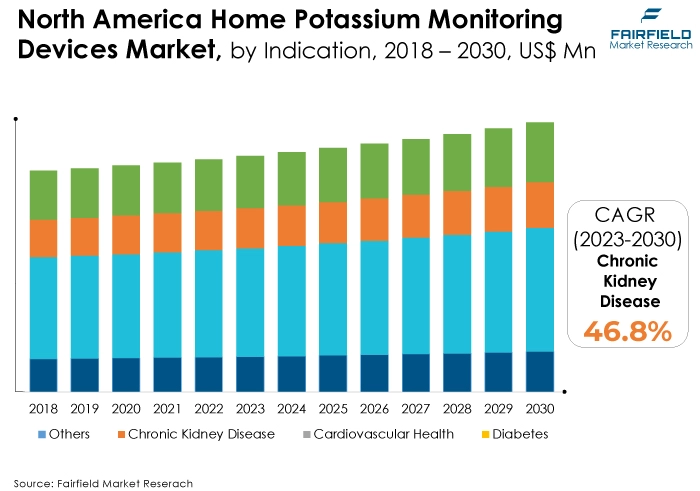
Fairfield’s Competitive Landscape Analysis
The market for home potassium monitoring devices is consolidated, with fewer significant competitors present worldwide. To increase their global footprint, the major firms are launching new items and enhancing their distribution networks. In addition, Fairfield Market Research anticipates that during the next few years, there will be further market consolidation.
Who are the Leaders in Global Home Potassium Monitoring Devices Space?
- Abbott Laboratories
- Trinity Biotech
- Cardinal Health
- Cepheid
- bioMerieux
- Novartis
- Bio-Rad Laboratories
- Hoffmann La Roche
- Danaher
- Siemens Healthineers
- Trividia Health
- Care Innovations, LLC
- Alio
- Kalium Health
- AstraZeneca
- AliveCor Inc.
Significant Company Developments
FDA Approvals
- June 2023: CardioRenal's potassium measurement gadget has been designated as a breakthrough device by the US Food and Drug Administration (FDA). The Tenor device combines potassium measuring technology with an app and cloud capabilities to give patients with chronic renal disease remote potassium analysis monitoring.
- March 2023: Alio, a company that specializes in wireless remote patient monitoring, has acquired FDA approval to incorporate potassium, hematocrit, and hemoglobin monitoring into their non-invasive SmartPatch system. A dermal patch tracks blood measurements and delivers the data to an online portal, which alerts clinicians to changes in the patient's health status.
Collaboration Agreements
- August 2023: Kalium Health, a Cambridge University spinoff producing an at-home blood potassium test, has inked a substantial R&D collaboration, and has now acquired enough data to begin preparing for clinical review. Kalium is working on an integrated device-software platform that can read electrolytes quantitatively from a single drop of blood. The company's first goal is to improve the management of CKD management by accurately measuring potassium levels.
- March 2021: AstraZeneca and AliveCor recently announced a new agreement to study innovative disease management solutions in the cardiovascular, renal, and metabolism (CVRM) therapeutic domains. The collaboration will transfer AliveCor's potassium detection technology and science, which allows for potassium assessment without blood draws, into real-world disease management applications and solutions.
Acquisition Agreement
- January 2020: Masimo, a global leader in noninvasive monitoring technologies, and NantHealth, Inc., a next-generation, evidence-based, personalized healthcare company, announced the signing of a definitive agreement in which Masimo will acquire the Connected Care assets from NantHealth, Inc. for an upfront cash payment of $47.25 million. NantHealth's Connected Care solutions enable hospitals and health systems to interoperate medical devices.
An Expert’s Eye
Demand and Future Growth
An increase in the prevalence of chronic kidney diseases is driving the market. The rising demand for devices may result from the growing elderly population, where home potassium monitoring devices are favoured in large quantities, increasing the need for home potassium monitoring devices.
Furthermore, technological developments have greatly aided the growth and development of various home potassium monitoring devices, mainly in hospitals. However, the home potassium monitoring devices market is expected to face considerable challenges because of frequent product recalls.
Supply Side of the Market
According to our analysis, by releasing new models in the desktop category, the manufacturers who are active in the market for home potassium monitoring devices are concentrating on boosting machine capabilities and competencies, which will enable end users to operate more effectively and efficiently. The US is the major exporter and manufacturer of home potassium monitoring devices.
The home potassium monitoring devices industry in the United States was estimated to be about 175 million dollars in 2015 and was projected to reach over 536 million dollars by 2022. With the presence of major manufacturing organizations in the area, the US dominated the market.
In Asia Pacific, China is the leading supplier of monitoring devices. China comes in second place with 23,469 exports, trailing the United States as the top exporter of patient monitoring systems with 24,308 shipments. China’s exports are predicted to increase due to the COVID-19 pandemic crisis.
Global Home Potassium Monitoring Devices Market is Segmented as Below:
By Product:
- Wearable Sensors
- Portable ECG Monitors
- Urine Test Strips
- Others
By Indication:
- Chronic Kidney Disease
- Cardiovascular Health
- Diabetes
- Others
By Geographic Coverage:
- North America
- U.S.
- Canada
- Europe
- Germany
- U.K.
- France
- Italy
- Turkey
- Russia
- Rest of Europe
- Asia Pacific
- China
- Japan
- South Korea
- India
- Southeast Asia
- Rest of Asia Pacific
- Latin America
- Brazil
- Mexico
- Argentina
- Rest of Latin America
- Middle East & Africa
- GCC
- South Africa
- Egypt
- Nigeria
- Rest of Middle East & Africa
1. Executive Summary
1.1. Global Home Potassium Monitoring Devices Market Snapshot
1.2. Future Projections
1.3. Key Market Trends
1.4. Regional Snapshot, by Value, 2022
1.5. Analyst Recommendations
2. Market Overview
2.1. Market Definitions and Segmentations
2.2. Market Dynamics
2.2.1. Drivers
2.2.2. Restraints
2.2.3. Market Opportunities
2.3. Value Chain Analysis
2.4. Porter’s Five Forces Analysis
2.5. COVID-19 Impact Analysis
2.5.1. Supply
2.5.2. Demand
2.6. Impact of Ukraine-Russia Conflict
2.7. Economic Overview
2.7.1. World Economic Projections
2.8. PESTLE Analysis
3. Global Home Potassium Monitoring Devices Market Outlook, 2018 - 2030
3.1. Global Home Potassium Monitoring Devices Market Outlook, by Product, Value (US$ Mn), 2018 - 2030
3.1.1. Key Highlights
3.1.1.1. Wearable Sensors
3.1.1.2. Portable ECG Monitors
3.1.1.3. Urine Test Strips
3.1.1.4. Others
3.2. Global Home Potassium Monitoring Devices Market Outlook, by Indication, Value (US$ Mn), 2018 - 2030
3.2.1. Key Highlights
3.2.1.1. Chronic Kidney Disease
3.2.1.2. Cardiovascular Health
3.2.1.3. Diabetes
3.2.1.4. Others
3.3. Global Home Potassium Monitoring Devices Market Outlook, by Region, Value (US$ Mn), 2018 - 2030
3.3.1. Key Highlights
3.3.1.1. North America
3.3.1.2. Europe
3.3.1.3. Asia Pacific
3.3.1.4. Latin America
3.3.1.5. Middle East & Africa
4. North America Home Potassium Monitoring Devices Market Outlook, 2018 - 2030
4.1. North America Home Potassium Monitoring Devices Market Outlook, by Product, Value (US$ Mn), 2018 - 2030
4.1.1. Key Highlights
4.1.1.1. Wearable Sensors
4.1.1.2. Portable ECG Monitors
4.1.1.3. Urine Test Strips
4.1.1.4. Others
4.2. North America Home Potassium Monitoring Devices Market Outlook, by Indication, Value (US$ Mn), 2018 - 2030
4.2.1. Key Highlights
4.2.1.1. Chronic Kidney Disease
4.2.1.2. Cardiovascular Health
4.2.1.3. Diabetes
4.2.1.4. Others
4.2.2. BPS Analysis/Market Attractiveness Analysis
4.3. North America Home Potassium Monitoring Devices Market Outlook, by Country, Value (US$ Mn), 2018 - 2030
4.3.1. Key Highlights
4.3.1.1. U.S. Home Potassium Monitoring Devices Market by Product, Value (US$ Mn), 2018 - 2030
4.3.1.2. U.S. Home Potassium Monitoring Devices Market by Indication, Value (US$ Mn), 2018 - 2030
4.3.1.3. Canada Home Potassium Monitoring Devices Market by Product, Value (US$ Mn), 2018 - 2030
4.3.1.4. Canada Home Potassium Monitoring Devices Market by Indication, Value (US$ Mn), 2018 - 2030
4.3.2. BPS Analysis/Market Attractiveness Analysis
5. Europe Home Potassium Monitoring Devices Market Outlook, 2018 - 2030
5.1. Europe Home Potassium Monitoring Devices Market Outlook, by Product, Value (US$ Mn), 2018 - 2030
5.1.1. Key Highlights
5.1.1.1. Wearable Sensors
5.1.1.2. Portable ECG Monitors
5.1.1.3. Urine Test Strips
5.1.1.4. Others
5.2. Europe Home Potassium Monitoring Devices Market Outlook, by Indication, Value (US$ Mn), 2018 - 2030
5.2.1. Key Highlights
5.2.1.1. Chronic Kidney Disease
5.2.1.2. Cardiovascular Health
5.2.1.3. Diabetes
5.2.1.4. Others
5.2.2. BPS Analysis/Market Attractiveness Analysis
5.3. Europe Home Potassium Monitoring Devices Market Outlook, by Country, Value (US$ Mn), 2018 - 2030
5.3.1. Key Highlights
5.3.1.1. Germany Home Potassium Monitoring Devices Market by Product, Value (US$ Mn), 2018 - 2030
5.3.1.2. Germany Home Potassium Monitoring Devices Market by Indication, Value (US$ Mn), 2018 - 2030
5.3.1.3. U.K. Home Potassium Monitoring Devices Market by Product, Value (US$ Mn), 2018 - 2030
5.3.1.4. U.K. Home Potassium Monitoring Devices Market by Indication, Value (US$ Mn), 2018 - 2030
5.3.1.5. France Home Potassium Monitoring Devices Market by Product, Value (US$ Mn), 2018 - 2030
5.3.1.6. France Home Potassium Monitoring Devices Market by Indication, Value (US$ Mn), 2018 - 2030
5.3.1.7. Italy Home Potassium Monitoring Devices Market by Product, Value (US$ Mn), 2018 - 2030
5.3.1.8. Italy Home Potassium Monitoring Devices Market by Indication, Value (US$ Mn), 2018 - 2030
5.3.1.9. Turkey Home Potassium Monitoring Devices Market by Product, Value (US$ Mn), 2018 - 2030
5.3.1.10. Turkey Home Potassium Monitoring Devices Market by Indication, Value (US$ Mn), 2018 - 2030
5.3.1.11. Russia Home Potassium Monitoring Devices Market by Product, Value (US$ Mn), 2018 - 2030
5.3.1.12. Russia Home Potassium Monitoring Devices Market by Indication, Value (US$ Mn), 2018 - 2030
5.3.1.13. Rest of Europe Home Potassium Monitoring Devices Market by Product, Value (US$ Mn), 2018 - 2030
5.3.1.14. Rest of Europe Home Potassium Monitoring Devices Market by Indication, Value (US$ Mn), 2018 - 2030
5.3.2. BPS Analysis/Market Attractiveness Analysis
6. Asia Pacific Home Potassium Monitoring Devices Market Outlook, 2018 - 2030
6.1. Asia Pacific Home Potassium Monitoring Devices Market Outlook, by Product, Value (US$ Mn), 2018 - 2030
6.1.1. Key Highlights
6.1.1.1. Wearable Sensors
6.1.1.2. Portable ECG Monitors
6.1.1.3. Urine Test Strips
6.1.1.4. Others
6.2. Asia Pacific Home Potassium Monitoring Devices Market Outlook, by Indication, Value (US$ Mn), 2018 - 2030
6.2.1. Key Highlights
6.2.1.1. Chronic Kidney Disease
6.2.1.2. Cardiovascular Health
6.2.1.3. Diabetes
6.2.1.4. Others
6.2.2. BPS Analysis/Market Attractiveness Analysis
6.3. Asia Pacific Home Potassium Monitoring Devices Market Outlook, by Country, Value (US$ Mn), 2018 - 2030
6.3.1. Key Highlights
6.3.1.1. China Home Potassium Monitoring Devices Market by Product, Value (US$ Mn), 2018 - 2030
6.3.1.2. China Home Potassium Monitoring Devices Market by Indication, Value (US$ Mn), 2018 - 2030
6.3.1.3. Japan Home Potassium Monitoring Devices Market by Product, Value (US$ Mn), 2018 - 2030
6.3.1.4. Japan Home Potassium Monitoring Devices Market by Indication, Value (US$ Mn), 2018 - 2030
6.3.1.5. South Korea Home Potassium Monitoring Devices Market by Product, Value (US$ Mn), 2018 - 2030
6.3.1.6. South Korea Home Potassium Monitoring Devices Market by Indication, Value (US$ Mn), 2018 - 2030
6.3.1.7. India Home Potassium Monitoring Devices Market by Product, Value (US$ Mn), 2018 - 2030
6.3.1.8. India Home Potassium Monitoring Devices Market by Indication, Value (US$ Mn), 2018 - 2030
6.3.1.9. Southeast Asia Home Potassium Monitoring Devices Market by Product, Value (US$ Mn), 2018 - 2030
6.3.1.10. Southeast Asia Home Potassium Monitoring Devices Market by Indication, Value (US$ Mn), 2018 - 2030
6.3.1.11. Rest of Asia Pacific Home Potassium Monitoring Devices Market by Product, Value (US$ Mn), 2018 - 2030
6.3.1.12. Rest of Asia Pacific Home Potassium Monitoring Devices Market by Indication, Value (US$ Mn), 2018 - 2030
6.3.2. BPS Analysis/Market Attractiveness Analysis
7. Latin America Home Potassium Monitoring Devices Market Outlook, 2018 - 2030
7.1. Latin America Home Potassium Monitoring Devices Market Outlook, by Product, Value (US$ Mn), 2018 - 2030
7.1.1. Key Highlights
7.1.1.1. Wearable Sensors
7.1.1.2. Portable ECG Monitors
7.1.1.3. Urine Test Strips
7.1.1.4. Others
7.2. Latin America Home Potassium Monitoring Devices Market Outlook, by Indication, Value (US$ Mn), 2018 - 2030
7.2.1. Key Highlights
7.2.1.1. Chronic Kidney Disease
7.2.1.2. Cardiovascular Health
7.2.1.3. Diabetes
7.2.1.4. Others
7.2.2. BPS Analysis/Market Attractiveness Analysis
7.3. Latin America Home Potassium Monitoring Devices Market Outlook, by Country, Value (US$ Mn), 2018 - 2030
7.3.1. Key Highlights
7.3.1.1. Brazil Home Potassium Monitoring Devices Market by Product, Value (US$ Mn), 2018 - 2030
7.3.1.2. Brazil Home Potassium Monitoring Devices Market by Indication, Value (US$ Mn), 2018 - 2030
7.3.1.3. Mexico Home Potassium Monitoring Devices Market by Product, Value (US$ Mn), 2018 - 2030
7.3.1.4. Mexico Home Potassium Monitoring Devices Market by Indication, Value (US$ Mn), 2018 - 2030
7.3.1.5. Argentina Home Potassium Monitoring Devices Market by Product, Value (US$ Mn), 2018 - 2030
7.3.1.6. Argentina Home Potassium Monitoring Devices Market by Indication, Value (US$ Mn), 2018 - 2030
7.3.1.7. Rest of Latin America Home Potassium Monitoring Devices Market by Product, Value (US$ Mn), 2018 - 2030
7.3.1.8. Rest of Latin America Home Potassium Monitoring Devices Market by Indication, Value (US$ Mn), 2018 - 2030
7.3.2. BPS Analysis/Market Attractiveness Analysis
8. Middle East & Africa Home Potassium Monitoring Devices Market Outlook, 2018 - 2030
8.1. Middle East & Africa Home Potassium Monitoring Devices Market Outlook, by Product, Value (US$ Mn), 2018 - 2030
8.1.1. Key Highlights
8.1.1.1. Wearable Sensors
8.1.1.2. Portable ECG Monitors
8.1.1.3. Urine Test Strips
8.1.1.4. Others
8.2. Middle East & Africa Home Potassium Monitoring Devices Market Outlook, by Indication, Value (US$ Mn), 2018 - 2030
8.2.1. Key Highlights
8.2.1.1. Chronic Kidney Disease
8.2.1.2. Cardiovascular Health
8.2.1.3. Diabetes
8.2.1.4. Others
8.2.2. BPS Analysis/Market Attractiveness Analysis
8.3. Middle East & Africa Home Potassium Monitoring Devices Market Outlook, by Country, Value (US$ Mn), 2018 - 2030
8.3.1. Key Highlights
8.3.1.1. GCC Home Potassium Monitoring Devices Market by Product, Value (US$ Mn), 2018 - 2030
8.3.1.2. GCC Home Potassium Monitoring Devices Market by Indication, Value (US$ Mn), 2018 - 2030
8.3.1.3. South Africa Home Potassium Monitoring Devices Market by Product, Value (US$ Mn), 2018 - 2030
8.3.1.4. South Africa Home Potassium Monitoring Devices Market by Indication, Value (US$ Mn), 2018 - 2030
8.3.1.5. Egypt Home Potassium Monitoring Devices Market by Product, Value (US$ Mn), 2018 - 2030
8.3.1.6. Egypt Home Potassium Monitoring Devices Market by Indication, Value (US$ Mn), 2018 - 2030
8.3.1.7. Nigeria Home Potassium Monitoring Devices Market by Product, Value (US$ Mn), 2018 - 2030
8.3.1.8. Nigeria Home Potassium Monitoring Devices Market by Indication, Value (US$ Mn), 2018 - 2030
8.3.1.9. Rest of Middle East & Africa Home Potassium Monitoring Devices Market by Product, Value (US$ Mn), 2018 - 2030
8.3.1.10. Rest of Middle East & Africa Home Potassium Monitoring Devices Market by Indication, Value (US$ Mn), 2018 - 2030
8.3.2. BPS Analysis/Market Attractiveness Analysis
9. Competitive Landscape
9.1. Product vs Indication Heatmap
9.2. Manufacturer vs Indication Heatmap
9.3. Company Market Share Analysis, 2022
9.4. Competitive Dashboard
9.5. Company Profiles
9.5.1. Abbott Laboratories
9.5.1.1. Company Overview
9.5.1.2. Product Portfolio
9.5.1.3. Financial Overview
9.5.1.4. Business Strategies and Development
9.5.2. Trinity Biotech
9.5.2.1. Company Overview
9.5.2.2. Product Portfolio
9.5.2.3. Financial Overview
9.5.2.4. Business Strategies and Development
9.5.3. Cardinal Health
9.5.3.1. Company Overview
9.5.3.2. Product Portfolio
9.5.3.3. Financial Overview
9.5.3.4. Business Strategies and Development
9.5.4. Cepheid
9.5.4.1. Company Overview
9.5.4.2. Product Portfolio
9.5.4.3. Financial Overview
9.5.4.4. Business Strategies and Development
9.5.5. bioMerieux
9.5.5.1. Company Overview
9.5.5.2. Product Portfolio
9.5.5.3. Financial Overview
9.5.5.4. Business Strategies and Development
9.5.6. Novartis
9.5.6.1. Company Overview
9.5.6.2. Product Portfolio
9.5.6.3. Financial Overview
9.5.6.4. Business Strategies and Development
9.5.7. Bio-Rad Laboratories
9.5.7.1. Company Overview
9.5.7.2. Product Portfolio
9.5.7.3. Financial Overview
9.5.7.4. Business Strategies and Development
9.5.8. Hoffmann La Roche
9.5.8.1. Company Overview
9.5.8.2. Product Portfolio
9.5.8.3. Financial Overview
9.5.8.4. Business Strategies and Development
9.5.9. Danaher
9.5.9.1. Company Overview
9.5.9.2. Product Portfolio
9.5.9.3. Business Strategies and Development
9.5.10. Siemens Healthineers
9.5.10.1. Company Overview
9.5.10.2. Product Portfolio
9.5.10.3. Financial Overview
9.5.10.4. Business Strategies and Development
9.5.11. Trividia Health
9.5.11.1. Company Overview
9.5.11.2. Product Portfolio
9.5.11.3. Financial Overview
9.5.11.4. Business Strategies and Development
9.5.12. Care Innovations, LLC
9.5.12.1. Company Overview
9.5.12.2. Product Portfolio
9.5.12.3. Financial Overview
9.5.12.4. Business Strategies and Development
9.5.13. Alio
9.5.13.1. Company Overview
9.5.13.2. Product Portfolio
9.5.13.3. Financial Overview
9.5.13.4. Business Strategies and Development
9.5.14. Kalium Health
9.5.14.1. Company Overview
9.5.14.2. Product Portfolio
9.5.14.3. Financial Overview
9.5.14.4. Business Strategies and Development
9.5.15. AstraZeneca
9.5.15.1. Company Overview
9.5.15.2. Product Portfolio
9.5.15.3. Financial Overview
9.5.15.4. Business Strategies and Development
9.5.16. AliveCor
9.5.16.1. Company Overview
9.5.16.2. Product Portfolio
9.5.16.3. Financial Overview
9.5.16.4. Business Strategies and Development
10. Appendix
10.1. Research Methodology
10.2. Report Assumptions
10.3. Acronyms and Abbreviations
|
BASE YEAR |
HISTORICAL DATA |
FORECAST PERIOD |
UNITS |
|||
|
2022 |
|
2018 - 2022 |
2023 - 2030 |
Value: US$ Million |
||
|
REPORT FEATURES |
DETAILS |
|
Product Coverage |
|
|
Indication Coverage |
|
|
Geographical Coverage |
|
|
Leading Companies |
|
|
Report Highlights |
Key Market Indicators, Macro-micro economic impact analysis, Technological Roadmap, Key Trends, Driver, Restraints, and Future Opportunities & Revenue Pockets, Porter’s 5 Forces Analysis, Historical Trend (2019-2021), Market Estimates and Forecast, Market Dynamics, Industry Trends, Competition Landscape, Category, Region, Country-wise Trends & Analysis, COVID-19 Impact Analysis (Demand and Supply Chain) |
